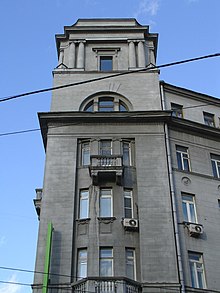Russian Neoclassical Revival
It is characterized by a merger of new technologies (steel frame and reinforced concrete) with a moderate application of classical orders and the legacy of the Russian Empire style of the first quarter of the 19th century.
Art Nouveau never reached the "universal" status: the Church relied on Russian Revival tradition, while the charities and the majority of homeowners used the economical "red brick" eclecticism.
[10] Ivan Fomin specifically praised the universal, easy-to-reproduce set of classical rules, consolidating the profession: "When the style was being formed, all the masters in the capital and the provinces worked toward the same end, not fearing to imitate one another.
Ilya Repin publicly condemned it as a lust for luxuries of "the filthy Arakcheyev period, and all the harshness of living suffered by millions, which are now free" (Russian: "Он напоминает мне поганое время Аракчеева и всей связанной с этим временем тягости жизни миллионов теперь свободных людей").
[16] Contemporaries clearly identified revival of the Empire style as a part of a larger trend seeking the way out of the apparently insoluble crisis of the fin de siècle; Art Nouveau and decadence in general were perceived as the least of threats.
"[17] Depending on the function of the building, purity of the style varied from refined Palladian legacy in luxury mansions to superficial, shallow decorations of utilitarian apartment blocks.
Geometry of basic shapes, clean surfaces... returned the integrity and monumentality that was lost in second half of 19th century" ("Обретение простоты... геометризация объемов, очищение плоскости возвращали архитектуре черты слитности, монументальности, утраченные во второй половине 19 века"[18]).
Pure revival of the Empire style was limited to temporary exhibition projects and suburban and country mansions, where abundant land allowed low but wide symmetrical layouts.
Typical Saint Petersburg construction projects of that period already passed the 5-story mark, unheard of in early 19th century, and needed careful adaptation of Neoclassical spirit to the new scale.
Early attempts at mechanical, superfluous attachment of columns and porticos to ordinary apartment blocks failed; by 1912 the problem was resolved, most notably by Vladimir Shchuko.
His Markov Apartments suggested two ways of handling the scale: either by use of the giant order, with pilasters running the whole height of the building, or by adaptation of earlier Palladian motifs; both relied on expensive natural stone finishes and modern structural engineering.
On the contrary, the number of Neo-Renaissance projects in 1910s Saint Petersburg was great enough for that style to become a lasting trend; the works of Schuko and Lyalevich were instantly copied by lesser-known followers.
Alexander Benois and Georgy Lukomsky, now disillusioned by superfluous copying of Empire style motives, welcomed the "stern tastes of Italian architects".
[2] Modernized Neoclassicism, not related to Russian heritage or its Palladian roots, was exemplified in the new building of the German Embassy in Saint Isaac's Square, designed by Peter Behrens in 1911 and completed by Mies van der Rohe in 1912.
These buildings, usually called cloudbreakers (Russian: тучерезы), usually appeared outside of the Garden Ring: the city restricted high-rise construction in the historical center, including the ban on Ivan Mashkov's 13-story tower in Tverskaya Square that could become Moscow's first skyscraper.
In Saint Petersburg, Ivan Fomin and Fyodor Lidwal started redevelopment of Goloday Island – a residential park spanning over one square kilometer, the largest single project of the period.
Some of the architects, especially those based in Saint Petersburg or having foreign citizenship (Fyodor Lidwal, Noy Seligson) emigrated too; some, like Ernst Nirnsee, disappeared in the fog of war.
However, the influential architects who shaped the Neoclassical movement (Fomin, Ivan Kuznetsov, Mayat, Schuko, Rerberg, Zholtovsky) remained in Soviet Russia and quickly restored their role as leaders of the profession.
Many have lost original interiors; in the decade following World War II some of Moscow's apartment buildings were built up (adding two or three stories was a common and inexpensive solution to the housing shortage), but their external styling survived.




